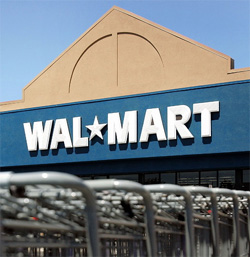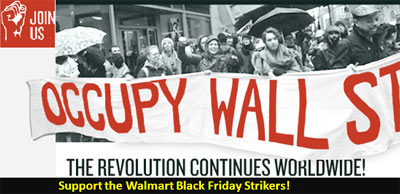Source: Far Eastern Economic Review Edited: Ac. Krtashivananda
 Wal-Mart Stores Inc., headquartered in rural Bentonville, Arkansas (population 29,000), is the world’s largest corporation, with annual revenues approaching the $350 billion range. Wal-Mart’s revenues are larger than the combined GDPs of Hong Kong and Malaysia. Wal-Mart imported about $27 billion in merchandise from China last year—about the same as did Singapore. What began 45 years ago when hillbilly entrepreneur Sam Walton launched a no-frills mom-and-pop discount store in a remote corner of the American South, now is a corporate empire that spans the globe. In the United States, Wal-Mart directly employs a workforce of about 1.4 million so-called “associates” who work in 4,000-plus Spartan big-box stores.
Wal-Mart Stores Inc., headquartered in rural Bentonville, Arkansas (population 29,000), is the world’s largest corporation, with annual revenues approaching the $350 billion range. Wal-Mart’s revenues are larger than the combined GDPs of Hong Kong and Malaysia. Wal-Mart imported about $27 billion in merchandise from China last year—about the same as did Singapore. What began 45 years ago when hillbilly entrepreneur Sam Walton launched a no-frills mom-and-pop discount store in a remote corner of the American South, now is a corporate empire that spans the globe. In the United States, Wal-Mart directly employs a workforce of about 1.4 million so-called “associates” who work in 4,000-plus Spartan big-box stores.
As any casual reader of newspapers would know, opinions differ greatly as to whether that beast has economic beauty. There’s a sort of yin and yang as one begins to sort out the criticisms. To some on the conservative end of the economic spectrum, Wal-Mart is an inspiring entrepreneurial success story, its ruthless price-cutting a model of Adam Smith’s beneficent invisible hand. But to others who consider themselves liberals, Wal-Mart is an arrogant, union-busting employer that refuses to pay its own employees, many of whom don’t even have health insurance, decent wages.
Many other critics accuse Wal-Mart of exploiting hundreds of thousands of anonymous poor workers who work in the sweatshops in some of the poorer parts of the world—especially Asian countries like China, Bangladesh and the Philippines—that churn out all those cheap toys, clothing and so forth. To some of the corporation’s more energetic cyber critics who inhabit the blogosphere, Wal-Mart is a hated capitalistic “Satan.” Beyond the fringes, the growing chorus of Wal-Mart sentiments have now reached the mainstream of American politics, where anti-globalism sentiments are on the rise.
So how to sort out the “truth”?
The Truth About Wal-Mart
Wal-Mart is often accused of exercising what antitrust theorists call “monopsony” purchasing power, squeezing its suppliers for ever-lower prices until they go out of business. The blogosphere is full of accusations, for example, that Wal-Mart’s relentless cost-cutting pressures in the late 1990s eventually drove Vlasic Pickles into bankruptcy. Yet that story doesn’t check out. As recounted in author Charles Fishman’s The Wal-Mart Effect, an often-critical history that detailed Wal-Mart’s rise from mom and pop to an economic superpower, Vlasic was indeed pressured mercilessly to cut its prices for gallon jars of pickles, to the extent that profits were barely a penny a jar.
Indeed, Wal-Mart’s aisles are filled with products made by corporate giants, including famous brands like Pfizer’s Listerine, Kellogg’s Special K cereal, Procter & Gamble Co.’s Crest toothpaste, Johnson’s Baby Lotion, Gillette Razors and Bayer vitamins. Consumers should be delighted that Wal-Mart is on their side, squeezing the big players in a competitive marketplace, turning profits by offering lower prices to consumers. If it is true that hard-nosed capitalistic competition, viewed up close, is never pretty, it is also argued that the end result can serve an economic public good.
Wal-Mart’s critics quickly retort that these consumer savings come with a price tag that is taken off the hides of poor, often exploited, Asian workers who make the cheap blue jeans. Indeed, the criticisms don’t just come from the antitrade crowd. There is widespread, if understandably muted, agreement inside the rag trade that the criticisms are reasonable. While everyone in the clothing industry has to worry about sweatshops, Wal-Mart’s extreme cost-cutting business model appears to give the company’s contract suppliers incentives to cut costs by the usual sweatshop methods: refusing to pay statutory minimum wages, demanding excessive overtime hours and then cheating their workers out of overtime pay, secretly subcontracting parts work out to children, and otherwise skirting internationally accepted labor practices. Wal-Mart claims to be on top of the problems.
The End of the Production Line:
Chong Won (a garment manufacturing unit outside Manila) had folded, after a long struggle with workers, who said they had earned two or three dollars a day and had been pressing for a better deal. This is a familiar Philippine story, as contract workers are fired the day before their sixth month, thus allowing the employers to avoid paying legally required benefits such as health care. The one word for this is: exploitation.
Since 1994, Chong Won workers tried to form a union, hoping to negotiate a collective bargaining agreement. But the organizing efforts had been vigorously suppressed by the factory management, which paid scant heed to the Philippine freedom of association laws.
Ultimately an Union was formed and it recommended that Wal-Mart guarantee to keep buying clothes from Chong Won, provided the Korean owner would refrain from further illegal union-busting activities, and rehire the fired workers, with back pay (as provided by Philippine law). Wal-Mart apparently accepted the recommendations, but by then Chong Won had gone out of business, changing its name to C. Woo Trading (which presumably could reopen in another location, another familiar sweatshop tactic in poor Asian countries). By whatever corporate name, the Korean executives declined to respond to requests to be interviewed.
Meanwhile, back in the U.S., Wal-Mart faced criticism during 2008 presidential campaign trail for providing too many jobs to Asians. Mr. Obama then was quoted as telling a New York City audience that some American workers “now compete with their teenagers for minimum-wage jobs at Wal-Mart because their factory moved overseas.” Former Sen. John Edwards had not only campaigned against Wal-Mart and the globalization it stands for, but had staffed his campaign with anti-Wal-Mart activists.
Problem is, the political critics often have their own contradictions. Ms. Clinton was a former director of Wal-Mart. Mr. Edwards owned Wal-Mart stock before he ran for national office. And Mr. Obama’s wife, Michelle Obama, was associated with a company that supplies Wal-Mart with pickles, until she resigned, the association raised questions.
Perhaps, whatever one thinks about Wal-Mart, the greater cause for concern is with the double standard associated with politicians who want to become president of the world’s economic superpower by pandering for anti-globalist votes against America’s No. 1 employer.
Note: Forming of whole sale market by the smaller manufactures for consumer goods and by farmers for food products and selling it through multiple retailers in one big campus like in Singapore, Kathmandu (Nepal) and New market in Kolkata will be more cost effective for manufacturers and farmers and will also be democratic in character than economic dictatorship and monopolisation by the big corporations.
——————————————————–
Support the Walmart Black Friday Strikers!
Fellow occupier, it’s time to take a stand and support the workers who are standing up to live better through an unfair labor practice strike.
Walmart workers decided to strike on Black Friday after they were targeted for retaliation for speaking out about substandard work conditions and treatment last month in the first ever walk out in the history of the company.
The workers are demanding the following from Walmart:
- Improve Workers’ Lives
- Rebuild Communities
- Put Its Promises in Writing
- Elevate Global Living Standards

